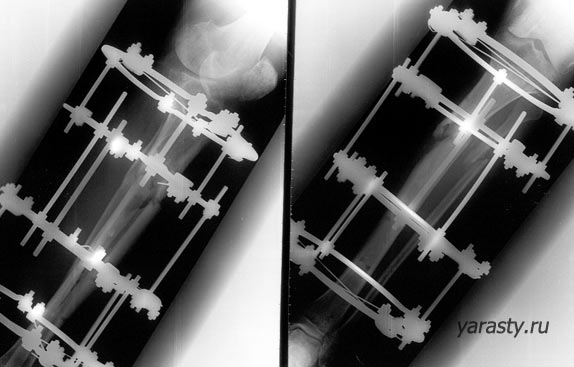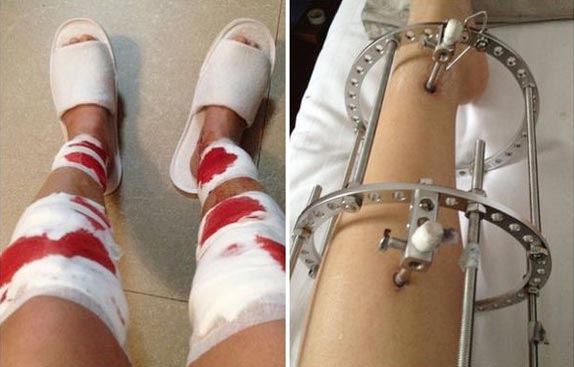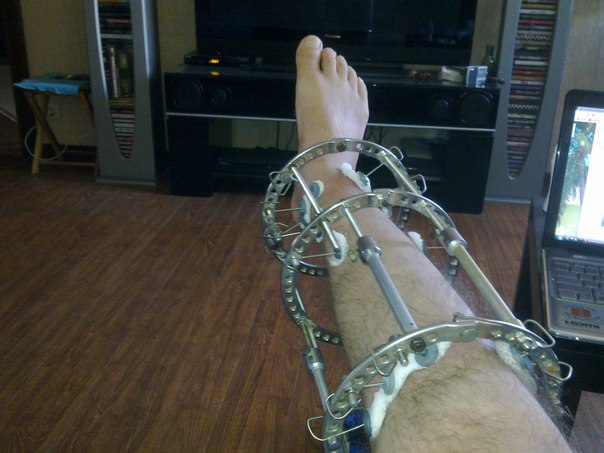Ilizarov's apparatus

Gavriil Abramovich Ilizarov (June 15, 1921, Bialowieza Białystok Voivodship of the Second Rzecz Pospolita (now Podlasie Province of Poland) - July 24, 1992, Kurgan) - an outstanding Soviet orthopedic surgeon, inventor, doctor of medical sciences (1968), professor. Academician of the USSR Academy of Sciences (1991, Corresponding Member 1987). Hero of Socialist Labor (1981). Honored Inventor of the USSR (1985). Honored Doctor of the RSFSR (1965). Honored Scientist of the RSFSR (1991). The winner of the Lenin Prize (1978).
Compression and distraction apparatus (Ilizarov apparatus, Shevtsov-Matsukatov apparatus) is a medical device intended for long-term fixation of bone fragments, as well as for its compression ("compression") or stretching ("distraction"), that is, for carrying out the so-called " Transosseous osteosynthesis. " The device is used to treat injuries, bone fractures of limbs, congenital deformities of bone tissue. Also used for "aesthetic" operations in anthropometric (orthopedic) cosmetology for elongation and straightening of the legs. The device is a metal "ring", on which are attached "knitting needles", passing through the bone tissue. The rings are connected by mechanical rods, allowing them to change their orientation at a speed of the order of one millimeter per day. The compression-distraction apparatus was first developed by the Soviet surgeon GA Ilizarov (author's certificate No. 98471 dated 09.06.1952).
With the help of Ilizarov's apparatus they extend limbs, correct various deformities of limbs, fix bone fragments in fractures. The device is constantly being improved and it has new applications in the treatment of various ailments of bones.
The history of the device creation by the physician GA Ilizarov

C for a long time in people's lives there are injuries, for example, broken legs, hands and so on. Relatively easy fractures doctors could treat, but when a person broke the bones unsuccessfully, they did not know what to do. And tied on the perimeter of the bed, and drove the wire into the bone, and wrapped the legs with magic sheets, but nothing helped. As a result, the fracture healed was bad, not to mention its appearance.
So it was almost up to now. The decision in the middle of the XX century was found by Gabriel Abramovich Ilizarov. He first proposed his device as a remedy for the treatment of severe fractures. Subsequently, his invention allowed not only to effectively treat fractures, but also to extend the bones, correct the curvature of the legs, treat many other complex diseases.
In the Kurgan specialized research institute dealing with orthopedics and traumatology, talk about the history of the invention of this device so. First, Ilizarov conducted experiments on broken shanks of the shovel, threading them with ordinary knitting needles. As a result, a real medical device for the treatment of fractures was gradually invented. The essence of it is as follows. Iron spokes pierce the bone. Further, these spokes are fixed on the iron rings, and the rings themselves are joined together by several bolts. Thus, the leg was fixed and had the opportunity to fuse better.
What is the modern apparatus of Ilizarov?

For several decades, constant work has been carried out to improve the apparatus. At present, the varieties of this design have, with the original pattern, both similarities and differences. Now instead of spokes often used rods of inert materials - titanium or carbon fiber. The rigid rings were replaced by semicircles, plates and triangles. The device became much lighter and smaller. It is increasingly being used not only to treat fractures, but also to extend limbs. To do this, initiate a very slow stretching of the bone, which creates tension in it and surrounding tissues. As a result, the formation of the bone callus is gradually proceeding - a new tissue, due to which the limb becomes longer.
Usually, the proportions of the patient's body are measured before the operation. This is done in order to find out how much you can increase the bone without a significant violation of the ratio of individual parts of the body. Elongate either the tibia or thigh. Simultaneously it is impossible. The doctor decides together with the patient what to lengthen.
In the set of the Ilizarov apparatus there are 30 parts. Details are produced in the pilot plant of our center and can be delivered at cost in the required quantity.
The main supports of the device:
- Rings are unreeled (Fig. 2a).
- Semirings (Fig. 2b).
- Arcs with holes (Figure 2c).
 Fig. 2a |
 Fig. 2b |
 Fig. 2c. |
Rings and semirings are produced in 11 sizes, depending on their internal diameter from 100 to 160 mm every 10 mm, and then 180-200 to 220 and 240 mm. The width of the annular support plane is 15 mm. The ring is the main support of the Ilizarov apparatus and is used in the treatment of the pathology of the bones of the upper and lower extremities.
Semirings can be connected together by means of laths, brackets and screw rods. In addition, to strengthen the fixation of the support, they can be connected to each other with the overlay on top of each other.
Arcs as the main supports are used mainly in the proximal parts of the limbs, have 7 typical sizes, depending on the radius of the inner surface of the arches. At the same time, they are 80-90-100-110-120-140 and 160 mm in radius. The width of the arc plane is 30 mm. The material for the manufacture of external supports is steel 20x13 GOST 563272.
Employees of the laboratory of biomechanical research conducted a study on the dependence of the deformation of the rings and arches of the apparatus on their rigidity and the tension of the spokes. The rings and arcs of all diameters under the tension of the spokes from 10 to 170 kg every 20 kg were subjected to the investigation. It was found that the rigidity of the arcs is 5 times lower than the stiffness of the rings. The forces that arise in the rings of the Ilizarov apparatus, from the effect of the tension of the spokes and the forces of compression and distraction, depend substantially on the way the device is assembled, on the angle of the crosses of the spokes, on the radius of the rings, on the number of rods and their location. The greatest margin of strength of the rings takes place at the angle of the crossing of the spokes 90 ° and the symmetrical arrangement of the 4 rods.
Additional external supports of the Ilizarov apparatus (Fig. 3a - c).
 Fig. 2a |
 Fig. 2b |
 Fig. 2c. |
Brackets with threaded shank and threaded hole (Fig. 3a) are 2, 3 and 4 hole ones. Are intended for fastening and tension of spokes, creation of the hinged joints, деротационных knots and systems for management of position of fragments, segments, splinters. Planks are flat, helical-shaped and radial with a number of holes from 2 to 10 (Figure 3b) Most often they are used to connect supports of different diameters, connecting rods, connecting supports installed in different planes, creating appropriate supports, taking into account the anatomy of the segment and to increase the circumference of the semiring , When they are installed in the proximal parts of the limb.The beams without and with threaded liners are most often used to connect the main external supports (rings, arches), fixing the spokes with the help of spicetaxers and distraction rods, reinforcing the fixation of supports and knots in the arrangement of apparatus with pathology, Requiring great efforts.
Washers: interlining, with groove, corrugated. They are used to correct the position of the spokes held in different planes, fastening the spokes and other options for mounting the apparatus (Figure 4).

Fig. 4.
Couplings threaded and bushings (Figure 5) are designed to facilitate the installation of the device in orthopedic pathology, namely: to extend the rods, fix additional supports (brackets, strips) with the subsequent installation and fastening of spokes or devices to perform the appropriate treatment task.

Fig. 5.
Rods with a continuous thread are designed to connect the main supports of the Ilizarov apparatus and the installation of various functional repositories in order to eliminate the displacement of fragments along the width, periphery, and the installation of hinged and other connections. In length, they are available in 6 sizes: 60, 80, 100, 120, 150 and 200 mm.
Telescopic rods are produced in 4 sizes depending on the length: 190, 220, 290, 380 mm. They are designed to connect the main supports, located at a great distance from each other. Combining the main external supports, the rigidity of the fixation is significantly increased and is most often used for elongation of limbs, removal of deformations and reassembly of the apparatus at the stage of changing the rigidity of fixing fragments (Fig. 6).

Fig. 6.
Threaded rods with a hole and a distraction groove are used in cases where it is necessary to move osteotomized fragments to replace defects, reposition bone fragments with improperly fusing and chronic fractures. The length of these rods varies from 40 to 120 mm every 10 mm.
At the stages of the development of parts, various spicetizers were used , which are shown in Figure 7.

Fig. 7.
At the present time, bolts are used with spigot fittings with a groove or hole , they are designed for fastening and tensioning the spokes to the main or auxiliary supports. With the help of the bolts of the spokes, you can not only fasten, but also tighten the knitting needles, as shown in the following figures.
In addition to the above-described parts, keys (end and carob), round nose pliers, cutters and spicer pullers (figure 8) are necessary for applying the device to tension the basic and repositionally fixing spokes.

Fig. 8.
In addition, bolts, nuts and a set of bits are required to perform compactotomies and corticotomies.
The spokes (Figure 9) are the connecting link between the bone and the outer supports of the apparatus. To perform transosseous osteosynthesis, most often used are spokes 1.5 and 1.8 mm in diameter. To strengthen the fixation stiffness, 2.0 mm spokes can be used. When applying the transosseous osteosynthesis method, fractures and pathologies of small tubular bones use 1.0 mm diameter spokes. The length of the spokes can be from 250 to 400 mm. Holding the spokes through the metaphyseal section does not present any difficulties and for this purpose knitting needles with a three-edged sharpening are most often used. In order to reduce traumatism when carrying the spokes through the diaphyseal sections of the bone, use spokes with a special sharpening, most often in the form of spear-shaped. Studies were carried out with the plating of spokes platinum, silver, graphite, but they have only historical, but not practical significance. Now, to stimulate bone formation, use spokes with different coatings.

Fig. 9.
To strengthen the fixation of bone fragments, to achieve their exact repositioning, and also to move the osteotomized fragments to replace bone defects, spokes with thrust areas in the form of bayonet, corkscrew bending, soldering from silver solder or stop due to the flattening of the spoke are used. The location of the thrust pads can be at different distances from the point of the spokes. With fractures of the pelvic bones, clavicle, sternum, the stop surfaces are located at a distance of 1.5 - 2.0 cm from the tip of the needle. With fractures of the cervix and the vertex of the femur, the stop surfaces are located at a distance that prevents penetration of the end of the needle into the hip joint. Most often, the stop surfaces are located in the middle of the spoke, which are called reposition fixation.
Spokes on the medullary canal and cortical bone can be transmedular, transcortical, parasal, and they can pass through both or one semicircle of the limb. At the present time, methods for intramedullary introduction of spokes have been developed.
Installation
The apparatus of Ilizarov refers to mechanisms of compression-distraction character. Therefore, its direct purpose is to distract or stretch and compress or compress, and, of course, prolonged fixation of individual bone fragments.
Any fracture involves the displacement of the edges of the bone, because the muscles pull them in different directions. The risk of bone edging is reduced to a minimum when the limb of Ilizarov apparatus is fractured. The device reliably fixes not yet fused fractures and false joints, without requiring additional immobilization with gypsum.
Together with the therapy of false joints and not yet fused fractures, this device is applicable with a positive effect if it is necessary to correct the length of the limb.
With a fracture of the limb, the process of installing Ilizarov's apparatus is as follows: With the help of a drill, the spokes of the apparatus are held two pieces through each bone fragment in the fracture region, the spokes crossed at an angle of ninety degrees. Each pair of spokes in each bone fragment is fixed with a ring or semicircle with a special key.

Reduction of the compression force occurs due to deformation of the spokes.
The tension of the spokes is under constant control and daily regulation. With the skilful manipulation of mobile bars, any displacement of bone debris along the axis, angular deformations and a closed reposition of bone fragments are eliminated.
The process of elongating the legs with the help of Ilizarov's apparatus is a step-by-step process. The first stage is the application of the apparatus to the patient, the second stage - osteometry (dissection of the bone), the third stage - fixation of bone fragments with the help of the Ilizarov apparatus. Approximately seven days after this operation, a gradual process of distraction begins, that is, lengthening the legs.
Elongation of limbs occurs at a rate of one millimeter per day. The speed of stretching directly depends on the individual sensitivity of the procedure being tolerated. The elongation by five centimeters occurs approximately for fifty to seventy-five days. After the elongation period, the fixation period begins. And its duration, as a rule, exceeds the stretching period by a factor of two.
Not less than, in thirty days the operation on lengthening of the second extremity begins. All operations of this nature are conducted under general anesthesia. On the second day the patient can walk with crutches. The rehabilitation period should be accompanied by walking and swimming.
The curvature of the extremities is also corrected with the help of Ilizarov's apparatus. An operation is performed to dissect the bone at the site of its deformation. Then fixation is carried out in the correct position of the bone with the help of the Ilizarov apparatus.
Installation of the device is concluded in the introduction of the rods and holding the spokes through the bones. Correction of the curvature of the lower limbs can take place gradually, with daily correction, or at the same time, that is, correction is performed during the surgical operation. The patients are treated daily by themselves.
The Ilizarov apparatus is removed after the fusion of bones in the correct position.
Since the modern apparatus of Ilizarov has small overall dimensions, the patient is fully motivated almost immediately after the operation.
Advantages and disadvantages
The advantage of using the Ilizarov apparatus is that it allows a significant reduction in bone fusion in fractures and minimizes the risk of developing a false joint at the fracture site. Moreover, a partial load is allowed on the damaged limb as early as the second day after the operation and the procedure for installing the apparatus.

The shortcomings of the Ilizarov apparatus include such facts as:
- With rings it is inconvenient to lie and sit;
- In places of punctures there are scars of a point character, after removal of the apparatus;
- During the use of the apparatus, edema develops and the pain that disturbs sleep is not disturbing.
Withdrawal
The removal of Ilizarov's apparatus is carried out exclusively by a specialist. The device is removed, as a rule, without anesthesia and anesthesia.
The marks that remain after removal of Ilizarov's apparatus heal quickly enough. In order to speed up the healing process, you can use disinfectants. Scars on the removal sites remain, but they are usually of small size, and are practically invisible.
Schematic representation
We take a bone.

The spokes are made of stainless steel through the bones. One end of the needle is ground trihedral, the other end of the needle is inserted into the chuck of the guide device. It all looks like a drill drill a hole in the bone, and the spoke is like a drill.

Then the spokes are attached to the rings. The final rigidity of this design is attached to the threaded rods. In general, as you can see, everything is simple, factory-like. Reminds the Soviet children's designer.

Further, a fracture is made surgically (and in some cases, two, depending on how long it is necessary to extend the limb). Despite the anesthesia, during the strokes of the chisel on the bone, you feel good in the spine (I recall that the spinal anesthetic pains only the lower half of the body), so this is hellishly unpleasant.

Distraction. The purpose of this stage is to extend Ilizarov's apparatus and, accordingly, to lengthen the bone. The process is elementary - several times a day the nurse twists the nuts on your device, the nuts spin forward along the thread of the rod, push the rings, those in turn push the knitting needles and the spokes push the bones. Sensations after "twist" are not the most pleasant, you feel your leg stretched to the limit of string. I note that there are special electronic boxes that automatically and very smoothly make a twist (and as usually it will be visited, many bikes run as electronics failed, the boxes went crazy and literally tore their limbs). In the fracture between bone fragments a jelly-like substance is formed, which solidifies every day, so you can not lose time. Distraction stage is not particularly pleasant - but tolerable.

Regeneration. Sweet stage, if you compare with the service, you become a ladle, and you read the days before the demobilization. Elongation is completed, and the main thing is to help the bones to integrate as soon as possible. To do this, you are intensively eating calcium-containing foods, you go to exercise therapy, go to massage, and recover in a pressure chamber. Already nothing hurts, the device becomes the native integral part of you.

Removing the machine. The solemn moment to which you are preparing and waiting as the culmination, before which you worry like before an important exam. Someone is removed under anesthesia, someone so, always comes out in different ways. A control x-ray, the doctor gives the go-ahead for the removal of the device. Having unscrewed all nuts, having removed all rings, in a leg there are only spokes. This feeling of lightness can not be conveyed - it is so unusual that after losing 3-5 kilograms of cargo, the leg itself soars upwards. Spokes snack with ordinary nippers and pull out with pliers. Then the limb is gypsum, and the next day it is released on all four sides.
Recovery. It would seem that everything is finished. But a new life begins - you learn to walk, you struggle with the temple, you suffer pain, you learn to be a new person.



Comments
Commenting on, remember that the content and tone of your message can hurt the feelings of real people, show respect and tolerance to your interlocutors even if you do not share their opinion, your behavior in the conditions of freedom of expression and anonymity provided by the Internet, changes Not only virtual, but also the real world. All comments are hidden from the index, spam is controlled.